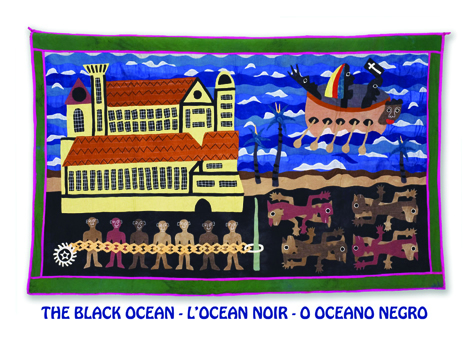
French artist William Wilson visits UNL for Hillestad Gallery exhibition
14 Apr 2010
From April 5 through 30, the Robert Hillestad Textiles Gallery in the Department of Textiles, Clothing & Design at the University of Nebraska-Lincoln hosted the exhibition “The Black Ocean: Europe - Africa - America” featuring appliquéd banner narratives documenting the complicated history of the infamous “triangle trade,” created by French artist William Wilson. The Paris-based multi-media artist was on campus from April 7 through 15, giving talks and offering exhibition walk-throughs with student, faculty and public groups including Lincoln Public School students.
"The Black Ocean: Europe-Africa-America" is Wilson's homage to his ancestors and his reflection on humanity and its capacity for both great achievement and nobility, and the basest horror and depravity. A painter, printmaker, sculptor, author and illustrator, Wilson recently journeyed to West Africa where, over a period of nearly two years, he worked with artisans in Abomey, Benin to create a series of eighteen appliqué fabric panels interpreting the historical narratives of the peoples of West Africa and of the traffic in human cargo that crossed oceans and generations. These powerful textiles bear witness to the richness of African culture and symbolism and the complex histories that interweave in reconstructing the African diaspora.

Artist William Wilson (center rear) discusses his work with students from TCD's Visual Literacy units working under the direction of lecturers Janine Copple and Michael Burton
In this collection of narrative-laden works, William Wilson has attempted to represent the concepts and aphorisms that aim to pass on the philosophy, ethics and belief systems at the root of Akan civilization and, more widely, of all human society. Wilson sought to locate himself intellectually and spiritually in relation to his European and African roots, to reconcile this divergent and complicated heritage, and to come to terms with the historical realities of African involvement in the slave trade, in its associated oral narratives, still being explored today, and in the broader implications of this history for all his fellow "travelers". "But this traveler is also you, readers and viewers," Wilson writes in the text accompanying the exhibition. "I invite you to explore this Black Ocean, tracing back a past that is far from concluded, since it holds the keys to understanding the present."
Textiles, Merchandising & Fashion Design